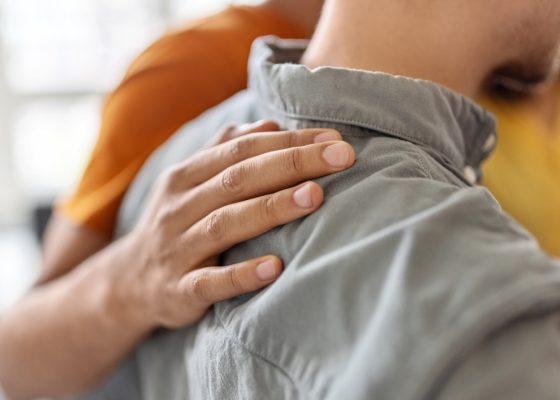Despite powerful stories and promising programs, none of us is doing enough to stop seven men from dying by suicide every day.
Every day in Australia, seven men take their own lives. Of the roughly 3200 people who died by suicide in 2023, males accounted for 75%. Men in rural and regional areas are even more at risk.
Suicide prevention is a national priority, but what’s become clear to those working closest to this issue is that there isn’t just a service gap – there’s a silence gap. Silence that, for some men, can be fatal.
Murray PHN CEO Matt Jones put it simply: we just aren’t doing enough.
“There’s a lot of activities going on in this area, that’s not to suggest they’re ineffective. That’s not to suggest that they’re not playing their role.
“But what really spoke to us is we’re not doing enough. It’s not just that we need to add more. It’s that we’re actually not doing enough,” he told Health Services Daily.
“It’s about recognising that for too long silence has facilitated the level of suicide that we’re seeing in men particularly. We need to be, as a society, actively recognising that and doing things to break that silence.”
To get the conversation going, Murray PHN has launched His Story. End Silence. End Suicide.
This public health campaign includes videos, posters, a website and images for social media, bringing attention to where people can access support and get more information and resources.
Importantly, it’s been developed with the help of a consumer reference group to increase awareness and to encourage help-seeking behaviour among men. The men featured in the campaign also have lived and living experience.
“It was entirely driven by the consumer reference group saying, ‘the issue is that we’re silent’. There is too much silence, and it needs to be called out and we need to have honest and open conversations,” said Mr Jones.
“Not talking about the concerns and issues that people are encountering or holding is contributing to suicide being the leading cause of death for males between the age of 15 and 45.
“People telling their stories and encouraging people not to let their story be defined by suicide…. Taking the definition of history in terms of that’s the last act of their life, and that defines their life,” he said.
Finding help in the community
Getting men to talk is also a key part of the suicide prevention work that The Healthy Communities Foundation Australia does.
“(There’s) stigma, stoicism, particularly amongst blokes and farmers who don’t talk much and would just prefer to get on with things,” CEO Jeremy Goff told Health Services Daily.
They also face a lack of culturally appropriate services in a place they can get to.
“Many people don’t really want to walk in the door of a clinic. That is if they can get to one, because clinics are often hours and hours away,” he said.
The Healthy Communities Foundation approach is a mobile, place-based model that combines clinical care with local engagement. With their National Rural and Remote Suicide Prevention Program (NRRSPP), they go into communities and provide mental health support where it’s needed.
“Our team includes mobile mental health nurses, peer support workers, and Aboriginal wellness workers who operate under clinical supervision. They offer crisis support, mental health education, and practical help to navigate the health system,” Mr Goff explained.
This community-first approach has already delivered more than 6500 episodes of care across Western NSW and parts of Queensland and Victoria. Ninety-six percent of clients have been supported safely in the community with only 13 people needing escalation to clinical settings.
It uses federal funding to upskill local residents and equip them with the knowledge and skills to deliver peer-led crisis support.
“We’re not only expanding the workforce – we are strengthening communities,” Mr Goff explained.
One way they do this is by partnering with the National Rugby League to provide practical support at rugby league training and games.
“The aim of this program is to engage with boys before they become men, or as they are becoming men, to give them the tools they need to manage their own mental health, to be able to talk about it,” said Mr Goff.
“We start on the side of the field while the team’s warming up. When they’re having the talk from the coach, one of our people, will come in and say, ‘Anyone want to have a chat about the issues we’re facing?’
Related
Their NRL partnership also gives them access to some rugby league players who come along and talk about how they’ve handled any mental health issues they’ve had.
“We’re changing the culture while the kids are young so that it’s fine to talk. It’s a safe environment,” Mr Goff said.
More investment in community services is needed
The statistics show how important this type of community-focused approach is in preventing suicide. According to Suicide Prevention Australia, its last community tracker found that 6% of men outside capital cities sought help from community service organisations. CEO Nieves Murray told HSD that this is an important shift.
“Why that’s an important number is that it’s up from 2.5% last year. It’s now taken over from seeking help from digital sources.
“It really marks a need for the investment in community services,” she said.
Community programs that work well are ones that are co-designed by the target population and include peer support mechanisms. Some of these include Ifarmwell and Mates in Construction.
“They’re the sorts of programs that we know help reduce stigma and provide supports without judgement. It means that men are more likely to access them and use them,” said Ms Murray.
While men have been identified as a risk group in the National Suicide Prevention Strategy, what is needed is more targeted investment.
“At the moment there is a bit of a scattergun approach to the way we invest based on the quality of a submission,” Ms Murray said.
What is needed is an evaluation of what’s working so those programs can be scaled up so they’re accessible to all.
“Things like Men’s Sheds we know are effective. Things like The Men’s Table is another that is peer-led that we know are effective, they’ve been evaluated. So we need to be investing in those programs and scaling them up so that men can access them wherever they might be,” she said.
Funding time periods are also a problem.
“Funding a program for three years and then having an end date doesn’t lead to security of that program being there in perpetuity.
“So ensuring that when governments fund programs, they fund them so that the organisations can set up a structure that ensures that people can access those services when they need them, rather than be constantly chasing the next contract with government,” she said.
Every story shared, every conversation started, every bloke who speaks up instead of staying quiet are small acts of resistance against a deadly silence. But they’re not enough on their own.
According to Ms Murray, every part of government has a role to play in the prevention of suicide.
So do every one of us.
“I think that’s a really important takeaway, that people recognise they can themselves can make a difference.
“It’s not just about clinicians or professionals,” she concluded.




